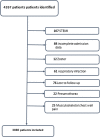30 day predicted outcome in undifferentiated chest pain: multicenter validation of the HEART score in Tunisian population
- PMID: 34798811
- PMCID: PMC8603499
- DOI: 10.1186/s12872-021-02381-z
30 day predicted outcome in undifferentiated chest pain: multicenter validation of the HEART score in Tunisian population
Abstract
Background: Chest pain remains one of the most challenging serious complaints in the emergency department (ED). A prompt and accurate risk stratification tool for chest pain patients is paramount to help physcian effectively progrnosticate outcomes. HEART score is considered one of the best scores for chest pain risk stratification. However, most validation studies of HEART score were not performed in populations different from those included in the original one.
Objective: To validate HEART score as a prognostication tool, among Tunisian ED patients with undifferentiated chest pain.
Methods: Our prospective, multicenter study enrolled adult patients presenting with chest pain at chest pain units. Patients over 30 years of age with a primary complaint of chest pain were enrolled. HEART score was calculated for every patient. The primary outcome was major cardiovascular events (MACE) occurrence, including all-cause mortality, non-fatal myocardial infarction (MI), and coronary revascularisation over 30 days following the ED visit. The discriminative power of HEART score was evaluated by the area under the ROC curve. A calibration analysis of the HEART score in this population was performed using Hosmer-Lemeshow goodness of test.
Results: We enrolled 3880 patients (age 56.3; 59.5% males). The application of HEART score showed that most patients were in intermediate risk category (55.3%). Within 30 days of ED visit, MACE were reported in 628 (16.2%) patients, with an incidence of 1.2% in the low risk group, 10.8% in the intermediate risk group and 62.4% in the high risk group. The area under receiver operating characteristic curve was 0.87 (95% CI 0.85-0.88). HEART score was not well calibrated (χ2 statistic = 12.34; p = 0.03).
Conclusion: HEART score showed a good discrimination performance in predicting MACE occurrence at 30 days for Tunisian patients with undifferentiated acute chest pain. Heart score was not well calibrated in our population.
Keywords: Admission avoidance; Chest pain; Emergency service; Myocardial infarction; Severity of illness index.
© 2021. The Author(s).
Conflict of interest statement
The authors declare that they have no competing interests.
Figures
Similar articles
-
Heart rate n-variability (HRnV) and its application to risk stratification of chest pain patients in the emergency department.BMC Cardiovasc Disord. 2020 Apr 10;20(1):168. doi: 10.1186/s12872-020-01455-8. BMC Cardiovasc Disord. 2020. PMID: 32276602 Free PMC article.
-
Sex-Based Differences in the Performance of the HEART Score in Patients Presenting to the Emergency Department With Acute Chest Pain.J Am Heart Assoc. 2017 Jun 21;6(6):e005373. doi: 10.1161/JAHA.116.005373. J Am Heart Assoc. 2017. PMID: 28637780 Free PMC article.
-
Evaluation and comparison of six GRACE models for the stratification of undifferentiated chest pain in the emergency department.BMC Cardiovasc Disord. 2020 Apr 25;20(1):199. doi: 10.1186/s12872-020-01476-3. BMC Cardiovasc Disord. 2020. PMID: 32334528 Free PMC article.
-
HEART Score Risk Stratification of Low-Risk Chest Pain Patients in the Emergency Department: A Systematic Review and Meta-Analysis.Ann Emerg Med. 2019 Aug;74(2):187-203. doi: 10.1016/j.annemergmed.2018.12.010. Epub 2019 Feb 2. Ann Emerg Med. 2019. PMID: 30718010
-
Prognostic Accuracy of the HEART Score for Prediction of Major Adverse Cardiac Events in Patients Presenting With Chest Pain: A Systematic Review and Meta-analysis.Acad Emerg Med. 2019 Feb;26(2):140-151. doi: 10.1111/acem.13649. Epub 2018 Nov 29. Acad Emerg Med. 2019. PMID: 30375097
Cited by
-
HEART versus GRACE Score in Predicting the Outcomes of Patients with Acute Coronary Syndrome; a Systematic Review and Meta-Analysis.Arch Acad Emerg Med. 2023 Jul 19;11(1):e50. doi: 10.22037/aaem.v11i1.2001. eCollection 2023. Arch Acad Emerg Med. 2023. PMID: 37609535 Free PMC article. Review.
References
-
- Rui P, Kang K. National Hospital Ambulatory Medical Care Survey: 2017 emergency department summary tables. National Center for Health Statistics. Available from: https://www.cdc.gov/nchs/data/nhamcs/web_tables/2017_ed_web_tables-508.pdf
-
- Amsterdam EA, Wenger NK, Brindis RG, et al. 2014 AHA/ACC guideline for the management of patients with non–st-elevation acute coronary syndromes: a report of the American College of Cardiology/American Heart Association Task Force on Practice Guidelines. J Am Coll Cardiol. 2014;64:139–228. doi: 10.1016/j.jacc.2014.09.017. - DOI - PubMed
Publication types
MeSH terms
Substances
LinkOut - more resources
Full Text Sources
Medical





